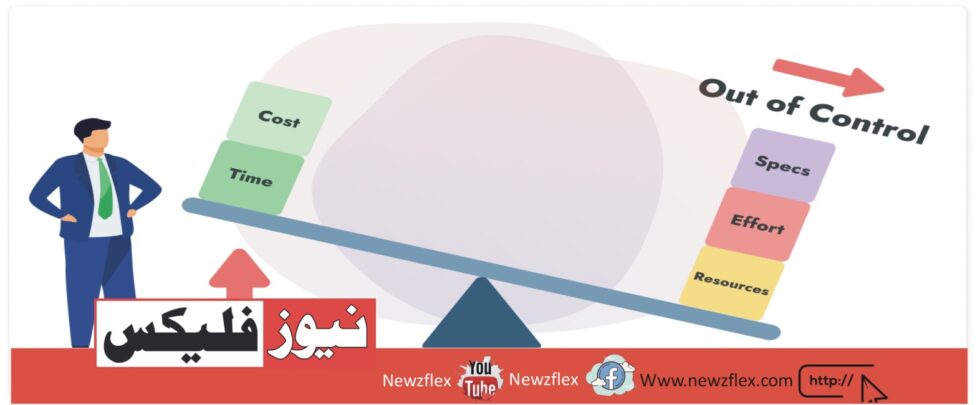
Your project is facing scope creep. How can you prevent delays and resource drain?
آپ کے منصوبے کو دائرے کی زیادتی کا سامنا ہے۔ آپ تاخیر اور وسائل کے ضیاع کو کیسے روک سکتے ہیں؟
دائرے کی زیادتی بہت سے منصوبوں کی خاموش قاتل ہوتی ہے۔ یہ چھوٹے، غیر محسوس تبدیلیوں کے ذریعے اندر آتی ہے، جو اس قدر بڑھ جاتی ہیں کہ وقت کی حدیں پھسل جاتی ہیں اور بجٹ بڑھ جاتا ہے۔ مسئلہ؟ زیادہ تر ٹیمیں صرف اس وقت محسوس کرتی ہیں کہ وہ مشکل میں ہیں جب یہ بہت دیر ہو چکی ہوتی ہے۔
لیکن دائرے کی زیادتی ناگزیر نہیں ہے—یہ اس وقت ہوتی ہے جب ترجیحات کی وضاحت ختم ہو جاتی ہے، توقعات کو طے نہیں کیا جاتا، اور حدود دھندلی ہو جاتی ہیں۔ کامیابی کے لیے، ہمیں دائرے کے انتظام کے طریقے کو دوبارہ سوچنا ہوگا۔
آئیں ہم پرانی سوچ سے آزاد ہوں اور ٹریک پر رہنے کی پوشیدہ سچائیاں جانیں۔ یہاں آپ کو دائرے کی زیادتی سے بچنے کے لیے کچھ نکات ہیں جو وسائل کو نہیں کھینچتے اور آپ کے منصوبے کو متاثر نہیں کرتے۔
نمبر1 : ہر مرحلے پر کامیابی کی تعریف نو کریں
دائرے کی زیادتی اکثر اچھی نیتوں سے شروع ہوتی ہے—ویلیو بڑھانے، نئی درخواستوں کو پورا کرنے، یا ضروریات کی پیشگی تصدیق کرنے کی کوشش۔ لیکن سچ یہ ہے: زیادہ خصوصیات کا مطلب زیادہ کامیابی نہیں ہوتا۔ کامیابی کو منصوبے کی ترقی کے ساتھ ترقی کرنی چاہیے۔
آخر تک اس کا اندازہ لگانے کے انتظار نہ کریں۔ اس کے بجائے، ہر مرحلے پر پوچھیں: “کیا یہ کام ہمیں ہمارے مقصد کے قریب لا رہا ہے؟” اگر نہیں، تو یہ ایک حواس باختگی ہے۔ کامیابی کی تعریف کو مسلسل نوکرنا یہ یقینی بناتا ہے کہ آپ کا منصوبہ پتلا اور توجہ مرکوز رہے۔
نمبر2 : ہر نئی درخواست کو چیلنج کریں
دائرے کی زیادتی کو روکنے کا سب سے مشکل حصہ “نہیں” کہنا ہے۔ تمام درخواستیں ایک جیسی نہیں ہوتیں۔ صرف ایک اضافی خصوصیت شامل کرنا بے ضرر لگتا ہے—جب تک کہ وہ ایک نہیں بن جاتی۔ چال یہ ہے کہ پوچھیں: کیا یہ تبدیلی ہمارے بنیادی مقاصد سے ہم آہنگ ہے؟
اگر جواب واضح نہیں ہے، تو یہ دوبارہ غور کرنے کا وقت ہے۔ ان درخواستوں کے خلاف مزاحمت کریں جو حقیقی ویلیو نہیں بڑھاتی۔ سب کچھ ہاں کہنا صرف انتشار پیدا کرتا ہے۔ ارادے سے رہیں، اور یاد رکھیں کہ دائرے کا تحفظ منصوبے کی حفاظت کرتا ہے۔
نمبر3 : پہلے ہی توقعات طے کریں اور انہیں باقاعدگی سے دوبارہ دیکھیں
منصوبے کا دائرہ پتھر پر نہیں لکھا گیا ہے۔ یہ ایک زندہ معاہدہ ہے جس کی مسلسل دیکھ بھال کی ضرورت ہے۔ لیکن بہت سے اوقات، ٹیمیں فرض کرتی ہیں کہ ایک ہی اجلاس کافی ہے۔ یہ کافی نہیں ہے۔ توقعات کو پہلے طے کریں، لیکن یہاں تک نہ رکیں—انہیں باقاعدگی سے دوبارہ دیکھیں۔
اپنے اسٹیک ہولڈرز سے پوچھیں: “کیا آپ کی ترجیحات تبدیل ہوئی ہیں؟” دائرے کی زیادتی سے پہلے رہیں، نہ کہ اس کا رد عمل کریں۔ باقاعدہ چیک ان بعد میں حیرتوں سے بچاتے ہیں۔
نمبر4 : پیشرفت کو ٹریک کریں، صرف کام نہیں
صرف کاموں کو ٹریک کرنا کافی نہیں ہوگا اگر آپ کا دائرہ پہلے ہی پھسل رہا ہو۔ آپ کو کلیدی مقاصد کی جانب پیشرفت کو ٹریک کرنے کی ضرورت ہے۔ کیا آپ ترسیل کے قریب آ رہے ہیں، یا آپ صرف مزید کام مکمل کر رہے ہیں؟ روزمرہ کے کاموں کی ہلچل میں منزل کا نظر انداز کرنا آسان ہے۔
منصوبے کو سنگ میلوں میں تقسیم کریں۔ ہر سنگ میل کو منصوبے کی کامیابی کے معیار سے براہ راست جوڑنا چاہیے۔ پیشرفت زیادہ کرنے کے بارے میں نہیں ہے—یہ وقت پر صحیح چیزیں کرنے کے بارے میں ہے۔
نمبر5 : جب بات چیت کرنا ہو تو جانیں، صرف تسلیم نہ کریں
بہت سی ٹیمیں آرڈر لینے کی عادت میں مبتلا ہو جاتی ہیں۔ جب کوئی اسٹیک ہولڈر کچھ نیا مانگتا ہے، تو وہ بغیر سوال کیے فراہم کر دیتے ہیں۔ لیکن ہر درخواست عمل کے لائق نہیں ہوتی۔ حقیقی چستی کا مطلب ہے کہ یہ جاننا کہ کب بات چیت کرنی ہے۔
پوچھیں: “اگر ہم یہ خصوصیت شامل کریں، تو ہم کیا نکال سکتے ہیں؟” سمجھوتے ٹریک پر رہنے کا حصہ ہیں۔ تجارت میں طاقت ہے۔ وقت کی حفاظت کے لیے سخت بات چیت کی ضرورت ہوتی ہے، نہ کہ اندھی تسلیم۔
نمبر6 : اضافی کام کی پوشیدہ قیمت کو ظاہر کریں
ہر اضافی کام کسی اور جگہ سے وسائل نکالتا ہے۔ دائرے کی زیادتی کا مسئلہ صرف مزید کام نہیں ہے—یہ کھوئی ہوئی موقع کی قیمت ہے۔ ٹیمیں کم اہم تبدیلیوں کے لیے ضروری کاموں کی قربانی دیتی ہیں۔ یہ اضافیاں کن چیزوں کو نہیں ہونے دیتی ہیں؟
جب آپ کچھ نیا کہتے ہیں تو آپ پہلے سے منصوبہ بند چیز کو کہہ رہے ہیں۔ ان تجارتوں کو واضح کریں۔ اپنی ٹیم اور اسٹیک ہولڈرز کو اضافی کام کے پیچھے پوشیدہ قیمتیں دکھائیں۔ یہ وضاحت بہتر فیصلوں کے لیے مجبور کرتی ہے۔
نمبر7 : ایک موثر تبدیلی کے کنٹرول کے عمل کا استعمال کریں
زیادہ تر تبدیلی کے کنٹرول کے عمل ناکام ہوجاتے ہیں کیونکہ وہ بیوروکریسی بڑھاتے ہیں بجائے وضاحت۔ تبدیلی کے انتظام کا مقصد درخواستوں کو روکنا نہیں ہے—یہ یہ یقینی بنانا ہے کہ صحیح درخواستیں گزرتی ہیں۔ عمل کو سادہ رکھیں: فیصلہ کون کرتا ہے؟
کون سے معیار اہم ہیں؟ تبدیلی کا وقت اور بجٹ پر کیا اثر پڑتا ہے؟ ہر درخواست کو دستاویز کریں، اور منظوریوں کو منصوبے کے مقاصد سے جوڑیں۔ ایک شفاف عمل یہ یقینی بناتا ہے کہ تبدیلیاں منصوبے کی خدمت کرتی ہیں، اسے نہیں بگاڑتی۔
نمبر8 : ٹیم کو متفق رکھیں، صرف آگاہ نہ کریں
صرف بات چیت آپ کے منصوبے کو نہیں بچائے گی۔ بہت سی ٹیمیں اس سوچ میں مبتلا ہو جاتی ہیں کہ معلومات کا اشتراک کرنا یہ یقینی بناتا ہے کہ سب ایک صفحے پر ہیں۔ لیکن ہم آہنگی معلومات سے زیادہ ضروری ہے—یہ مشترکہ سمجھ کی طلب کرتی ہے۔
اپنی ٹیم سے پوچھیں: “کیا ہم ایک ہی مقصد کی طرف کام کر رہے ہیں، یا صرف مصروف ہیں؟” جب ہر رکن دائرے کی حدود کو سمجھتا ہے، تو وہ منصوبے کی توجہ کے محافظ بن جاتے ہیں۔ انہیں مشترکہ مقاصد کے ذریعے متفق رکھیں، صرف ای میلز اور میٹنگز کے ذریعے نہیں۔
نمبر9 : تبدیلی کو قبول کریں بغیر اس کے کنٹرول میں آنے دیے
دائرے کی زیادتی اس وقت ہوتی ہے جب ٹیمیں تبدیلی کو روکنے یا نظر انداز کرنے کی کوشش کرتی ہیں یہاں تک کہ بہت دیر ہو جائے۔ لیکن تبدیلی ناگزیر ہے۔ چال یہ ہے کہ آپ اس کا جواب کیسے دیتے ہیں۔ ہر تبدیلی منصوبے کو متاثر نہیں کرتی۔
تبدیلیوں کو توجہ کو تیز کرنے کے مواقع کے طور پر دیکھیں۔ پوچھیں: “یہ تبدیلی ہمیں بہتر طریقے سے فراہم کرنے میں کیسے مدد دیتی ہے؟” تبدیلی کے جواب میں آپ کی نیت جتنی زیادہ ہوگی، اتنی ہی کم طاقت یہ منصوبے کو متاثر کرنے کی ہوگی۔
کافی کہنے کے فن میں مہارت حاصل کریں
دائرے کی زیادتی صرف بہت کچھ شامل کرنے کے بارے میں نہیں ہے—یہ یہ جاننے کے بارے میں ہے کہ کب رکنا ہے، چاہے مزید کرنے کا دباؤ ہو۔ اگر کم کرنا زیادہ قیمت دے سکتا ہے تو کیا ہوگا؟
آپ کے دائرے کی حفاظت کرنا سختی کے بارے میں نہیں ہے—یہ آپ کے منصوبے کے بنیادی مقصد کی پابندی کرنے کے بارے میں ہے۔ متغیر ماحول میں تیز رہنے کے لیے مزید دلچسپ بصیرت کے لیے، نیوزفلیکس پر جائیں۔
آخر میں، کامیابی توجہ مرکوز رکھنے سے آتی ہے، نہ کہ صرف لچکدار ہونے سے۔ اپنے وسائل کی حفاظت کریں۔ اپنے وقت کی حفاظت کریں۔ اور سب سے اہم بات، جانیں کہ کب کہنا ہے، یہ کافی ہے۔








